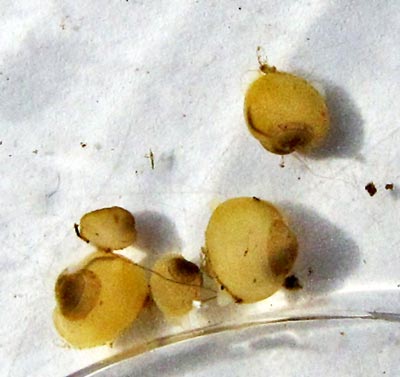Howdy, BugFans,
It’s been a long time since we turned our backs on the winged and the legged bugs and even longer since we got our gills wet. The fingernail clam, an outlier in our extended family of bugs, is a small “bug” with a big story. Novice BugFans please note—the BOTW definition of “bug” more closely matches that of a first-grader than that of an entomologist.
Fingernail Clams
If you scoop the bottom of most any soft-bottomed pond or lake or slow-moving river or stream in the country, you’re bound to come up with some fingernail clams (FnCs) (though they are happiest in still waters). The BugLady visits them at a nearby vernal pool. They prefer substrates of sand, mud and clay where, under optimum conditions, 10,000 FnCs may reside in a one square meter space, but they also hang out on plant stems. FnCs are tiny (most are less than ½”), but there’s a lot going on in that little bitty space. They are beige, smooth, thin-shelled creatures. They have a foot—a muscular appendage that they extend and contract in order to move ahead and down—but no head, and they have muscles that open and close their shell. They use a two-siphon system for feeding, breathing, and eliminating. Two, two-lobed gills are fastened on their ventral (lower) side (yes—clams have a “right side up”), and they have sense organs that help them maintain equilibrium. Where the multi-purpose inner lining of the shell (the mantle) sticks out past the shell edges, it can sense touch and light, and the FnC steers away from both.
FnCs are Mollusks (along with snails, clams, octopi and squid). The BugLady will attempt no more specific classification than “fingernail clam in the family Sphaeriidae.” There are five genera and about 40 species of FnCs in the U.S., and if you want to identify different species, you’ll need a microscope. A good one; in his exceedingly thorough Freshwater Invertebrates of the United States, Pennak says that “The nomenclature of the Sphaeriidae is in a greatly confused state.”
According to Pennak, “Fresh-water mussels are thought to have first developed in the New World, and more specifically, in the general area of the Mississippi drainage basin, for it is here that the greatest diversity of species occurs.” The concept of a barely-half-inch wingless, aquatic critter starting out in mid-country and taking over America (and the world) is fairly astonishing, no matter how much geologic time you give it, but it turns out that FnCs “think outside the pond.” They attach to water plants as tiny juveniles, and the water plants attach to the feet of water birds, and water birds DO have wings. Sometimes the clam-ettes clamp directly onto feathers, amphibians, or mobile aquatic insects (clam and clamp both derive from Old English “clamm,” “to bond or fetter”). In addition, some species of FnC are ingested by ducks but not digested, and they may be regurgitated alive at some distance from home.
FnCs are filter-feeders, taking in oxygen and very small pieces of organic matter—mini-plankton and tiny pieces of leaves that were broken down by other leaf-feeders—through one siphon and releasing wastes and indigestibles through the other. FnCs are food for fish, crayfish, aquatic amphibians, waterfowl and shore birds. They have competition; one study showed that invasive zebra mussels in parts of Lake Michigan “out-filtered” and “kicked out” the FnCs in the study area.
Their life span is a year or two. They are slightly more tolerant of pollution than other clams, and like other Mollusks, FnCs like water that is calcium-rich, the better to build shells with. They survive the winter cold and the seasonal drying of temporary ponds by retreating as deep as 8” (16+ times their body length) into the muck. If you happen to be pawing through the dead leaves in a dry depression in the woods in fall, the shells of dead FnCs will tell you that you are in a vernal pond.
FnCs are hermaphroditic (to review—hermaphroditic means that they house both genders in the same cute little body). Not only are the Sphaeriidae hermaphroditic, they are also self-fertilizing (no lines; no waiting), so the genetic apple doesn’t fall very far from the tree. It reminds the BugLady of a classic folk song called “I’m My Own Grandpa.”
Young are produced all year long and the two to twenty offspring that result from each “reproductive event” are confined in the water tubes of the gills. The egg/offspring-swollen gill is called a marsupial sac or marsupium, and several cohorts may be present simultaneously. Mom/Dad provides nutrients that supplement the yolk material. Within each of those brood chambers, there are young of different sizes, because they don’t all hatch at the same time within the marsupium.
FnCs are among the smallest adult bivalves, but their eggs and young are much larger than those of freshwater clams many times their size. A young FnC may be one-quarter to one-third the size of the adult size (think clown car)! The young are big and Mom/Dad is not, so something has to give. In the end, the larger, older young out-compete the smaller young for space and nutrients in a Darwinian sibling rivalry that weeds the crop. Weeds it so well, in fact, that in one species of FnCs that was studied, only about 2% of the eggs that were produced annually made it to the outside world. If they do complete their development, juvenile FnCs are released into the water as fully-formed mini-clams (other freshwater clams release young in a temporarily-parasitic larval stage).
The BugLady

